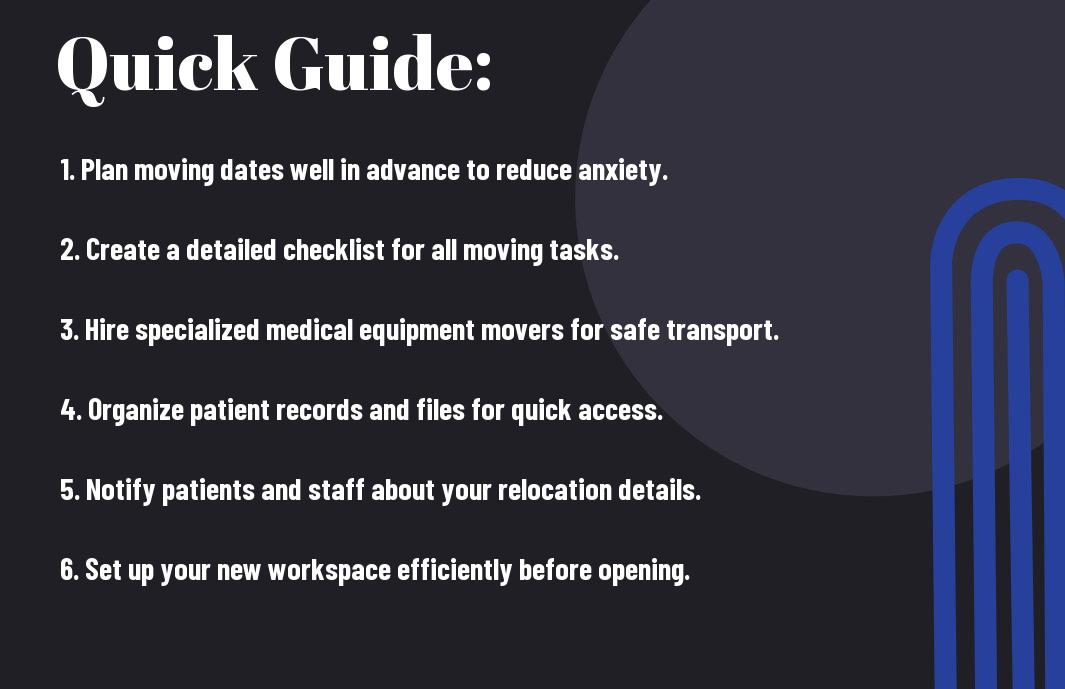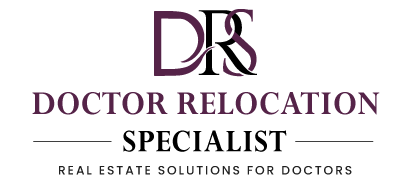This guide is designed to simplify your moving experience as a medical professional. Transitioning to a new location can be overwhelming, but with the right strategies and resources, you can make this process smooth and manageable. You’ll discover vital tips that cater specifically to your unique needs, from planning your move to finding reliable assistance. Whether you’re relocating for a new job or personal reasons, our insights will empower you to navigate this change with ease and confidence.

Understanding the Types of Doctor Moving Assistance
For medical professionals, choosing the right type of moving assistance is crucial for a smooth transition. You can find a variety of options tailored to your specific needs:
| Type of Assistance | Description |
| Professional Moving Services | Full-service movers specialize in handling the complexities of a doctor’s relocation. |
| DIY Moving Options | An alternative where you manage your own moving process using personal resources. |
| Virtual Office Relocation | Transitioning your practice to a digital or remote format. |
| Packing Services | Hiring professionals to handle packing and unpacking. |
| Storage Solutions | Renting a space to safely store your items during your move. |
Thou must carefully evaluate the options to find what best suits your circumstances.
Professional Moving Services
Any time you decide to hire a professional moving service, you can expect expert help every step of the way. These services typically provide packing, transport, and unpacking, ensuring your medical equipment and personal belongings are handled with care.
DIY Moving Options
Assuming you prefer a hands-on approach, DIY moving options might be right for you. This method allows you to save money and tailor your move according to your schedule and preferences.
This moving option entails renting a truck, gathering packing materials, and enlisting friends or family for help. While it offers flexibility and potentially lower costs, it also requires more planning and effort on your part. Make sure you account for all tasks involved, from packing your office equipment to updating your patients about your new location.
Tips for a Stress-Free Move
Clearly, a stress-free move requires careful consideration and preparation. Here are some vital tips to guide you through the relocation process:
- Schedule your move during non-peak hours for minimal disruption.
- Label boxes according to which area they belong in your new space.
- Consider hiring professional moving services familiar with medical facilities.
- Develop a checklist to ensure you don’t forget important items.
Any plan you create should cater to your specific needs as a medical professional.
Planning Ahead
Ahead of your move, start outlining the steps involved for a seamless transition. Establish a timeline detailing when to pack, notify patients, and set up your new office. Consider the equipment and supplies you’ll need to transport and ensure they are packed safely. Implementing these preparations helps minimize last-minute surprises and fosters organization.
Communication with Staff and Patients
On your moving journey, keeping staff and patients informed is paramount. You want to communicate your relocation plans clearly to avoid confusion and anxiety both among your team and your patient base.
Understanding the importance of clear communication will help maintain trust during your move. Inform your staff of the timeline and procedures, allowing them to prepare for any role changes or adjustments in duties. For your patients, send out notifications well in advance about the move, including the new address and updated contact information. Keeping everyone in the loop not only eases the transition but also reassures them that your commitment to their care remains strong.
The Ultimate Guide To Stress-Free Doctor Moving Assistance – Step-by-Step Guide to a Successful Move
Your move can be seamless with a well-organized plan. Follow these important steps to ensure a successful transition for your medical practice:
| Step | Description |
| 1. Planning | Outline your needs and timeline for the move. |
| 2. Inventory | Document all equipment and supplies to be moved. |
| 3. Hire Movers | Research and select a moving company experienced with medical facilities. |
| 4. Notify Patients | Inform your patients about the upcoming move and any changes. |
| 5. Pack | Carefully label and pack all items ahead of the moving day. |
Preparing Your Medical Practice
Even with great care, the packing process for your medical practice can be daunting. Create a detailed plan for packing medical equipment, ensuring each item is handled appropriately. Utilize professional packing services if necessary, as they can help safeguard your instruments and supplies while easing your stress during this transition.
Executing the Move Day
Some aspects of move day can feel overwhelming, but having a structured approach will keep everything on track. On the day of the move, arrive early to oversee the loading process, confirm all items are accounted for, and coordinate with your moving team to ensure a smooth operation.
Understanding how to execute move day effectively can significantly alleviate stress. Coordinate with your staff to assign specific roles, ensure that equipment is loaded properly, and maintain clear communication with your moving company. This level of preparedness will help you transition seamlessly into your new facility, allowing you to focus on your patients and practice rather than logistics.
Factors to Consider When Choosing Moving Assistance
Once again, selecting the right moving assistance for your practice involves careful thought and consideration. You should evaluate various factors before making a choice:
- Experience with medical equipment
- Insurance and liability coverage
- Reviews and referrals from other medical professionals
- Service flexibility and availability
- Cost efficiency and transparency
The decision you make will significantly impact your transition.
Budget and Costs
For a successful move, it’s necessary to establish a clear budget. Identify all potential expenses, such as packing materials, labor costs, and any special services needed for your medical equipment. Knowing your limits will help you choose a service that aligns with your financial expectations.
Location and Accessibility
When choosing moving assistance, consider the location and accessibility of your new practice. Proximity to suppliers, patients, and additional healthcare facilities can impact your operational efficiency.
Assistance that understands the specific logistical challenges of your new location can aid in ensuring that your move is smooth and timely. Additionally, assess the accessibility for staff and patients, as this can influence the overall success of your practice at the new site. By selecting a moving service knowledgeable in navigating your area’s particularities, you can minimize disruptions and maintain focus on patient care throughout the transition.
Pros and Cons of Different Moving Options
Now, it’s important to weigh the pros and cons of different moving options when planning your transition. Understanding the advantages and disadvantages will help you make an informed decision that best suits your needs as a medical professional.
| Pros | Cons |
|---|---|
| Less Stressful | Higher Costs |
| Time-Saving | Dependent on Movers |
| Expert Handling of Items | Less Control Over the Process |
| Insurance Coverage | Potential for Damage |
| Convenience | Scheduling Challenges |
Advantages of Using Professional Movers
Options like hiring professional movers can significantly reduce the stress and time associated with your relocation. These experts handle everything from packing to transportation, ensuring that your valuable medical equipment and personal items are treated with care and delivered safely to your new location.
Disadvantages of DIY Movements
Using a DIY approach might seem cost-effective initially, but it often leads to unforeseen challenges. You may underestimate the time and effort required to pack, move, and set up your new space. Additionally, injuries can occur if you’re not experienced in lifting heavy items, and the risk of damaging valuable equipment is heightened without professional assistance.
To avoid the headaches that come with a DIY move, consider whether you have the necessary tools, resources, and time. Moving requires careful planning, especially in the medical field where equipment and supplies are vital. Rushing through this process can leave you feeling overwhelmed and impact your professional responsibilities. Evaluating your priorities against the DIY workload can help you make the right choice for a smooth transition.

Resources for Medical Professionals in Need of Moving Assistance
Keep in mind that moving can be a daunting task, especially for busy medical professionals. Fortunately, various resources are available to ease the burden. From professional moving services to online tools and community support, you can find the help you need to transition smoothly to your new practice or location. Utilizing these resources will give you more time to focus on what you do best—caring for your patients.
Online Tools and Checklists
Assistance with moving has never been easier thanks to various online tools and checklists designed specifically for busy professionals like you. Websites and apps provide detailed planning timelines, packing tips, and item checklists, helping you stay organized throughout the moving process. Leveraging these digital resources can significantly reduce stress and keep your move on track.
Networking with Other Professionals
Little do many know that networking with other medical professionals can provide invaluable moving assistance and insights. By connecting with fellow colleagues, you can access recommendations for reliable moving services, share tips for a smoother transition, or even find someone willing to lend a hand during the process.
This type of networking can also open doors to local resources, such as community groups or specialized services tailored for medical professionals. Engaging with others in your field not only enhances your support network but can also lead to lasting professional connections. Don’t hesitate to reach out to colleagues for their experiences and advice, making your move less daunting and more manageable.
Summing up
To wrap up, streamlining your move as a medical professional can enhance your productivity and reduce stress. By utilizing the strategies and resources highlighted in this guide, you can effectively manage logistics, prioritize tasks, and ensure a smooth transition. Be proactive in planning and lean on available support services designed specifically for doctors. This approach will allow you to focus on what truly matters—your practice and patient care—while achieving a hassle-free relocation experience.

